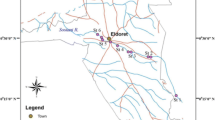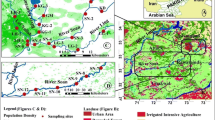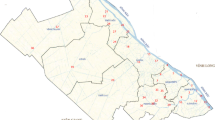Abstract
Various industrial facilities in the city of Varanasi discharge their effluent mixed with municipal sewage into the River Ganges at different discharge points. In this study, chemometric tools such as cluster analysis and box–whisker plots were applied to interpret data obtained during examination of River Ganges water quality. Specifically, we investigated the temperature (T), pH, total alkalinity, total acidity, electrical conductivity (EC), biochemical oxygen demand (BOD), chemical oxygen demand (COD), dissolved oxygen (DO), nitrate nitrogen (N), phosphate (PO 2−4 ), copper (Cu), cadmium (Cd), chromium (Cr), nickel (Ni), iron (Fe), lead (Pb), and zinc (Zn) in water samples collected from six sampling stations. Hierarchical agglomerative cluster analysis was conducted using Ward’s method. Proximity distance between EC and Cr was the smallest revealing a relationship between these parameters, which was confirmed by Pearson’s correlation. Based on proximity distances, EC, Cr, Ni, Fe, N, COD, temperature, BOD, and total acidity comprised one group; Zn, Pb, Cd, total alkalinity, Cu, and phosphate (PO 2−4 ) were in another group; and DO and pH formed a separate group. These groups were confirmed by Pearson’s correlation (r) values that indicated significant and positive correlation between variables in the same group. Box–whisker plots revealed that as we go downstream, the pollutant concentration increases and maximum at the downstream station Raj Ghat and minimum at the upstream station Samane Ghat. Seasonal variations in water quality parameters signified that total alkalinity, total acidity, DO, BOD, COD, N, phosphate (PO 2−4 ), Cu, Cd, Cr, Ni, Fe, Pb, and Zn were the highest in summer (March–June) and the lowest during monsoon season (July–October). Temperature was the highest in summer and the lowest in winter (November–February). DO was the highest in winter and the lowest in summer season. pH was observed to be the highest in monsoon and the lowest in summer season.








Similar content being viewed by others
References
APHA, AWWA, WEF. (2005). Standard methods for the examination of water and wastewater (21st ed.). USA: American Public Health Association/American Water works Association/Water Environment Federation.
Chen, G. N. (1993). Assessment of environmental water with fuzzy cluster analysis and fuzzy recognition. Analytica Chimica Acta, 271, 115–124.
Cieszynska, M., Wesolowski, M., Bartoszewicz, M., Michalska, M., & Nowacki, J. (2012). Application of physicochemical data for water-quality assessment of watercourses in the Gdansk municipality (South Baltic coast). Environmental Monitoring and Assessment, 184, 2017–2029. doi:10.1007/s10661-011-2096-5.
Deming, S. N., Michotte, Y., Massart, D. L., Kaufman, L., & Vandeginste, B. G. M. (1988). Chemometrics: a textbook. Amsterdam: Elsevier.
Giridharan, L., Venugopal, T., & Jayaprakash, M. (2009). Assessment of water quality using chemometric tools: a case study of river Cooum, South India. Archives of Environmental Contamination and Toxicology, 56, 654–669.
Hill, T., & Lewicki, P. (2007). Statistics: methods and applications: a comprehensive reference for science, industry and data mining. Tulsa: StatSoft.
Johnson, R. A., & Wichern, D. W. (2007). Applied multivariate statistical analysis (6th ed.). USA: Pearson Prentice Hall International.
Kar, D., Saur, P., Mandal, S. K., Saha, T., & Kole, R. K. (2008). Assessment of heavy metal pollution in surface water. International journal of Environmental Science and Technology, 5(1), 119–124.
Massart, D. L., & Kaufman, L. (1983). The interpretation of analytical chemical data by the use of cluster analysis. New York: Wiley.
Mishra, A., Mukherjee, A., & Tripathi, B. D. (2009). Seasonal and temporal variations in physico-chemical and bacteriological characteristics of River Ganga in Varanasi. International Journal of Environmental Research, 3, 395–402.
Otto, M. (2007). Chemometrics: statistics and computer application in analytical chemistry (2nd ed.). Germany: Wiley.
Singh, K. P., Malik, A., Mohan, D., & Sinha, S. (2004). Multivariate statistical techniques for the evaluation of spatial and temporal variations in water quality of Gomati River (India)—a case study. Water Research, 38, 3980–3992.
Singh, K. P., Malik, A., & Sinha, S. (2005). Water quality assessment and apportionment of pollution sources of Gomti River (India) using multivariate statistical techniques—a case study. Analytica Chimica Acta, 538, 355–374.
Tripathi, B. D., Sikandar, M., & Shukla, S. C. (1991). Physicochemical characterization of city sewage discharged into river Ganga at Varanasi, India. Environment International, 17, 469–478.
Vega, M., Pardo, R., Barrado, E., & Deban, L. (1998). Assessment of seasonal and polluting effects on the quality of river water by exploratory data analysis. Water Research, 32, 3581–3592.
Willet, P. (1987). Similarity and clustering in chemical information systems. New York: Wiley.
Xu, H., Yang, L. Z., Zhao, G. M., Jiao, J. G., Yin, S. X., & Liu, Z. P. (2009). Anthropogenic impact on surface water quality in Taihu lake region, China. Pedosphere, 19, 765–778.
Zhou, F., Liu, Y., & Guo, H. (2007). Application of multivariate statistical methods to the water quality assessment of the watercourses in Northwestern New Territories, Hong Kong. Environmental Monitoring and Assessment, 132, 1–13.
Acknowledgments
The authors are thankful to the University Grants Commission for financial support, the head (Prof. B.R. Chaudhray) of the Department of Botany for providing laboratory facilities, and the Institute of Agriculture and Soil Sciences for conducting heavy metal analysis using AAS.
Author information
Authors and Affiliations
Corresponding author
Rights and permissions
About this article
Cite this article
Kumari, M., Tripathi, S., Pathak, V. et al. Chemometric characterization of river water quality. Environ Monit Assess 185, 3081–3092 (2013). https://doi.org/10.1007/s10661-012-2774-y
Received:
Accepted:
Published:
Issue Date:
DOI: https://doi.org/10.1007/s10661-012-2774-y




